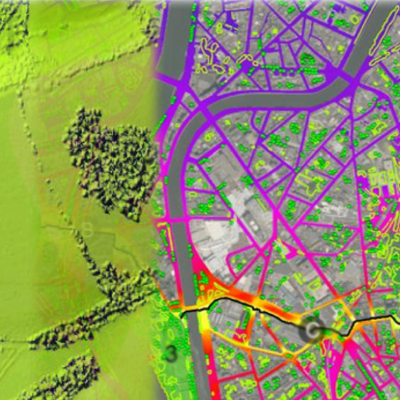There is an increasing focus on ecology within the Centre, especially in systems ecology relating to ecological restoration, soil ecology, biodiversity and interactions across the entire land use gradient and urban ecology. This has focused on the relationships between ecosystem composition, the importance and development of complexity, function and the emergence of system properties, especially resilience.
Our ability to observe, measure and obtain data on the environment is also becoming increasingly more straightforward and cost effective. As a result, the datasets we obtain are becoming larger and more complex. In the Ecology Group, we develop and apply numerical methods which summarise, analyse and recognise patterns in complex ecological and environmental datasets. We then capture these patterns as models and generate predictions on how the environmental system might behave or respond to external pressures. We use stochastic, statistical and process-based models in both the space and time domain.
Our research
- Environmental Data Sciences,
- Agricultural Informatics,
- Systems modelling.
Current research projects
- Ecosystem Goods and Services,
- Digital Soil Mapping,
- Ecological Indicators,
- Agricultural Informatics,
- Systems modelling.
Our research areas
Agricultural Data Sciences
Increasing data quantity and richness coupled to innovative informatics will support novel business, management and policy approaches in agricultural sector.
Agricultural systems are complex, with multi-tiered desired outcomes, some market driven, many others not. Policy outcomes from agricultural systems are also evolving, including outcomes in terms of ecosystem services or landscape stewardship that cannot immediately be monetarised, as well as monetary outcomes which cannot be directly predicted (such as marketable yield). We are interested here in the development of novel models and analytical methods which can provide insights and predictions of critical but hard to obtain outcomes from agricultural systems, developing an understanding of key drivers of ecological/environmental integrity and value, economic viability and farmer livelihood.
Determining effective Ecological / Environmental Indicators
The success of any policy intervention, change in land use or its management practices needs to be evidenced by measurable indicators of success.
In order to measure environmental quality, its function and services that are provided by the environment, indicators are commonly used. Indicators of ecological or environmental quality are required or desirable for monitoring/reporting and provide the basis for many protection policies and monitoring programmes. Indicators help assess human and natural impacts on the environment and ecosystems, including degradation processes. They also identify the effectiveness (or otherwise) of sustainable land management practices and restoration candidates for indicators, and provide supporting methodological information around sampling or monitoring schemes for these indicators. Indicators need to be sensitive to pressure and able to reflect change in environmental/ecological quality status (the capacity of the system to function) at any given location and time. Here we develop statistical methods by which to identify the appropriate candidates for indicators and provide supporting methodological information around sampling or monitoring schemes for these indicators.
- Corstanje, R., Mercer, T.G., Rickson, R.J., Deeks, L.K., Newell-Price, P., Holman, I., Kechavarsi, C. and Waine, T.W. Physical Soil Quality Indicators for Monitoring Soils. Solid Earth, DOI: 10.5194/se-2016-153 (2017).
- Corstanje, R, Grafius, D.R., Zawadzka, J., Moreira J., Vince, G., Ivanoff, D., Pietro, K., A datamining approach to identifying spatial patterns of P forms in the Stormwater Treatment Areas in the Everglades, US. Ecological Engineering, 97:567-576 (2016).
- Kral, F., Corstanje R., Veronesi F., White J.R. A Geostatistical Analysis of Wetland Soil Properties in the Davis Pond Mississippi River Freshwater Diversion. Soil Science Society of America Journal. 76: 1107-1118 (2012).
- Bostic, E.M., White, J.R., Corstanje, R., Reddy, K.R. Evidence of the spatial redistribution of wetland soil P ten years after the conclusion of nutrient loading. Soil Science Society of America Journal, 74: 1808-1815 (2010).
- Corstanje, R., Portier K.M., Reddy K.R. Discriminant analysis of biogeochemical indicators of nutrient enrichment in Florida wetlands. European Journal of Soil Science, 60: 974-981 (2009).
- Wright, A.L., Reddy K.R., Corstanje R. Patterns of heterotrophic microbial activity in eutrophic and oligotrophic peatlands. European Journal of Soil Biology, 45: 131-137 (2009).
- Corstanje, R., K. R. Reddy, J.P. Prenger, S. Newman and A.V. Ogram, Soil microbial eco-physiological response to nutrient enrichment. Ecological Indicators, 7:277-289 (2007).
Operationalising Ecosystem Services
Ecosystem Services are the benefits we obtain from our environment, yet their practical application remains complex, requiring spatial models that express quantity and flow of ecosystem services.
The concept of ecosystem services, defined as the benefits that humans obtain from nature (Millennium Ecosystem Assessment, 2005), has introduced a new dimension to the environmental discourse, that of natural capital. The conceptual aspect of natural capital in the ecosystem services approach opens up the opportunity for not only mitigating the potential negative environmental impacts but also optimizing the development to maximize the flow of ecosystem services. However, for this opportunity to be realised, methods and models that operationalise the ecosystems concept are required and need to be developed. These models need to be spatial, consider both current ecosystem services stocks and their flows, and be sufficiently dynamic to determine the effect of changes in land use or its management.
- Grafius, D.R., Corstanje, R., Siriwardena, G.M., Plummer, K.E., Harris, J. A., Bird’s Eye View: Connectivity and Landscape Structure in an Urban Environment. Landscape Ecology, doi:10.1007/s10980-017-0548-1 (2017).
- Nor, A.M.N., Corstanje, R., Harris, J., Grafius, D., Siriwardena, D. Ecological Connectivity Networks in Rapidly Expanding Cities. HELIYON, Volume 3(6): 325 (2017).
- Nor, A.M.N., Corstanje, R., Harris, J., Brewer, T., Impact of rapid urban expansion on green space structure. Ecological Indicators, 81: 274–284 (2017).
- Zawadzka, J., Corstanje, R., Fookes, J., Nichols J., Harris J., Operationalizing the ecosystems approach; assessing the environmental impact of major infrastructure works. Ecological Indicators, 78:75-84 (2017).
- Grafius, D.R, Corstanje, R., Warren, P., Evans, K., Hancock, S., Harris, J. The impact of land use/land cover scale on modelling urban ecosystem services. Landscape Ecology, 31:1509-1522 (2016).


